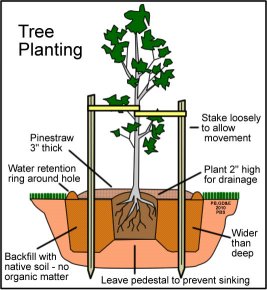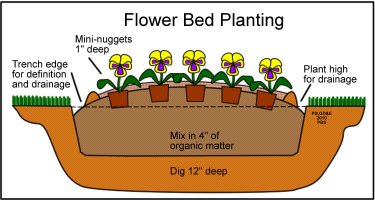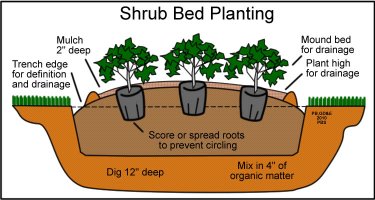
|

|

|
Ensure Success with Proper Planting
The greatest influences on the successful planting of plants are proper plant selection, proper soil preparation and proper watering techniques. If you are willing to spend the time to plant correctly, you will be rewarded with lush, healthy growth.
|
Click any picture to see an enlarged view... |
Choose the proper plant for the condition. Each location varies in the amount of sunlight and shade it receives, and how wet or dry it is. Choosing a plant that will be well adjusted to the existing conditions increases the odds of survival.
Water the plants before you plant them. Dry rootballs contain an air pocket which may prevent the rootball from absorbing water once it's planted. A wet rootball will form a good bond with the native soil and allow for better absorption of water.
Dig large planting holes, at least twice as deep and four times as wide as the rootball or container. This loose soil will allow the roots to spread quickly, allow water to be absorbed, and allow drainage. Even better, prepare the entire bed so that the roots have a large area of improved soil to grow into.
Mix organic matter into the soil to help build up the topsoil. 2" to 3" of compost, humus, or cow manure will keep the soil loose and enrich the soil as it decomposes. (To view discussion on the controvesy about adding organic matter see "The Organic Matter Controvesy"). Mix the organic matter thoroughly into the soil.
Plant the rootball 2" or 3" high for good drainage. A well kept secret is that roots need air. By placing the rootball 2" or 3" higher than the existing ground you can increase drainage during wet weather and allow better aeration to the roots. When you fill in the hole, cover the exposed rootball lightly with soil to prevent the wind from drying out the rootball.
Build a ring around the hole 2" or 3" high and 2 or 3 feet from the trunk to hold water around the planting hole when you plant. If you are preparing a bed, build a lip on the rim of the bed to hold water on the upper planting circle.
Mulch the plant with pinestraw or pinebark 2" deep. In addition to looking good, this will help keep the soil cool and moist in hot weather and warm in cool weather. The mulch will breakdown, adding organic matter to the soil. I recommend mini-nuggets for flower beds because you can till them into the soil at the end of the season for more organic matter.
Water the plant thoroughly when you are finished planting. Water frequently the first two weeks, then twice a week for a few weeks , then taper off to one thorough watering a week. Plants prefer one deep watering to stimulate deep root growth instead of lots of shallow waterings which promotes a shallow root system.
Fertilize the new planting with a complete fertilizer containing trace elements. Several small doses work better than one strong dose. Liquid fertilizers like Peter's or Miracle-Gro are excellent for new plantings.
 |
Paul Burns Atlanta, Georgia, USA |

Don't Tread on Me! |


